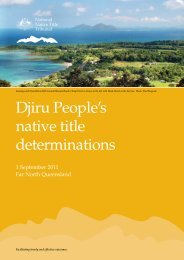Department <strong>of</strong> Main RoadsResponse from the Department <strong>of</strong> Main Roads has beenexemplary in responding to this conservation issue, with the<strong>Mission</strong> <strong>Beach</strong>-El Arish Road undergoing extensive work tominimise the risk <strong>of</strong> cassowary road death. C4 have <strong>report</strong>ed,upon implementation <strong>of</strong> these changes, that cassowarymortality on the road was greatly reduced (Hervey, 2003 pers.comm).The Department <strong>of</strong> Main Roads have a code <strong>of</strong> practice for theWet Tropics to minimise environmental impacts during roadmaintenance.CouncilCouncil manages all <strong>of</strong> the Shire's roads, other than privatelyowned roads, and <strong>State</strong> roads such as the highway and majorconnections.There have been no new roads created or roads closed inrecent years, but Council does continuously upgrade existingroads, within the constraints <strong>of</strong> its budget. Council alsodetermines speed limits, which can be raised where roads areupgraded. This potentially affects wildlife where roads passthrough natural areas.Council erects cassowary signs and other wildlife signagewhere appropriate. Further work is required to determinewhether there are significant risks to other species in the Shirefrom roads, but at present this is not considered likely. Actionwill be required if endangered or otherwise at risk species areidentified as affected. There is a need for connectivitybetween natural areas at a number <strong>of</strong> critical locations wherewildlife corridors are being established. Where these wildlifeconnective corridors cross roads, work is required to raisedriver awareness, reduce speeds or to provide a wildlifetunnel.Progress is currently ongoing in developing a Wildlife RoadManagement Plan for Council, to complement theBiodiversity Strategy.Rec: A Wildlife Road Management Plan be completed byCouncil, and implemented in conjunction with QPWS, theDepartment <strong>of</strong> Main Roads, ERGON, Powerlink, and otherstakeholders. Council implement the recommendationsdetermined for Local Government roads - Council, QPWS,Department <strong>of</strong> Main Roads, ERGON, Powerlink2.1.3 Alteration to Water Tables andNatural Drainage - Wetland Losses(Issues affecting stream flow and water levels in the Shire'swaterways and watertable are covered in the Water andAtmosphere chapter, section 2 - water quantity and demand.PressurePermanent alteration to the watertable and to natural drainagesystems threatens remaining habitats on the coastal plain.This area is naturally poorly drained, properly resulting inwetland ecosystems.Much <strong>of</strong> the native vegetation on the coastal plain has beencleared for agriculture and the land has then been subjected tomajor drainage works. These drainage works have led toalteration <strong>of</strong> the watertable, which has changed the dynamics<strong>of</strong> the vegetation. This is unfortunately a common problemthroughout coastal Australia.In Johnstone Shire many <strong>of</strong> the endangered ecosystems (seeTable 2.1.1c) are those that previously covered the lowlands,particularly the wetland ecosystems. A priority exists toprotect wetlands against further impacts from drainagealteration, and also from water allocation for human usage.Most <strong>of</strong> the endangered ecosystems in the Shire are protectedin reserves, but these areas can still be affected by changes toupstream drainage and water supply. This also applies toecosystems on private land.An associated problem with drainage is acid sulphate soils.These soil become acidic when exposed to the air, forexample when the water table is lowered by drainage. Theacidity raises pH in receiving waters, which can impactadversely on aquatic organisms.The absence <strong>of</strong> regular fire regimes is another factor currentlyaffecting wetland hydrology. Excess build-up <strong>of</strong> leaf litterover time blocks channels and raises the ground level. Whensaltwater intrusion occurs, especially during king tides, thesalt remains stored in this leaf litter rather than being flushedout again, adversely affecting the freshwater vegetation. Fireevents normally remove the excess leaf litter, unclogging thewetland system.The extent <strong>of</strong> wetlands in the Shire is very important becauseEubenangee Swamp38
<strong>of</strong> the vital role they play in determining water quality. TheShire's wetlands used to be floodwater retention basins.This meant that they both slowed movement <strong>of</strong> and storedlarge volumes <strong>of</strong> water during excess rainfall, and helpedfilter sediments and nutrients from the water. Wetlandshave further important functions as fishery habitat/nurseryareas, and food source areas for fish.Since their destruction, run<strong>of</strong>f volumes have increased, andlower reaches <strong>of</strong> the river are subject to increasedsedimentation and increased flooding. The removal <strong>of</strong>wetlands is an important part <strong>of</strong> the cause <strong>of</strong> sediment andnutrient problems affecting the Great Barrier Reef.Figure 2.1.3a - Changes to Wetlands in the JohnstoneRivers Catchment between 1951 and 1993Source: Russell and Hales (1993)Note: Scale depicted in the key does not apply hereIncreased sedimentation and flooding have impacts uponthe urban riparian areas in the Shire's towns, especiallyInnisfail, which is now looking at dredging its riverbeds.Historically, these river reaches were deep enough to allowfor large shipping. Now these reaches are so shallow theypose flood threats to urban areas.ConditionExtensive work has been conducted into the historicalrange <strong>of</strong> wetlands in the Shire (Russell and Hales 1993,Russell et al. 1996, Russell and Hales 1997). Work wasconducted for all four catchments in the Shire.They estimated the following changes to vegetation in theJohnstone Rivers catchment between 1951/2 and 1992(Table 2.1.3a). The areas were progressively cleared,drained and utilised for urban areas, agriculturalproduction, and grazing. The changes are also visuallyrepresented in Figure 2.1.3a.Table 2.1.3a - Changes to Wetland Vegetation Types inthe Johnstone Rivers CatchmentSource: Russell and Hales (1993)(Hectares) 1951 1992%changeMangroves 176 202 + 15%Melaleuca forests 1277 282 - 78%Mixed Melaleucacommunities462 258 - 44%Palm/Pandanus 439 160 - 64%Freshwater swamp/reeds 499 225 - 55%Total 2853 1127 - 60%The total area <strong>of</strong> wetlands in the Johnstone catchmentdecreased by approximately 60% over the 41 year period.All <strong>of</strong> the net losses were as the result <strong>of</strong> the reclamation <strong>of</strong>freshwater (non-mangrove) wetlands. The most significantlosses were <strong>of</strong> Melaleuca forest (78%) particularly to thesouth <strong>of</strong> the estuary, in the Ninds Creek Catchment. MixedMelaleuca communities also declined about 44%. Theother major freshwater wetland categories, palm/pandanusand freshwater swamp/reeds, were reduced by 64% and55% respectively. Freshwater wetlands to the north andwest <strong>of</strong> the river confluence have almost completelydisappeared. There was slight increase in the total area <strong>of</strong>mangroves due mainly to colonisation on the southernforeshore and at the mouth <strong>of</strong> Ninds Creek. Drainage andreclamation works continue to threaten the remainingsection <strong>of</strong> the Ninds Creek wetland area.39



